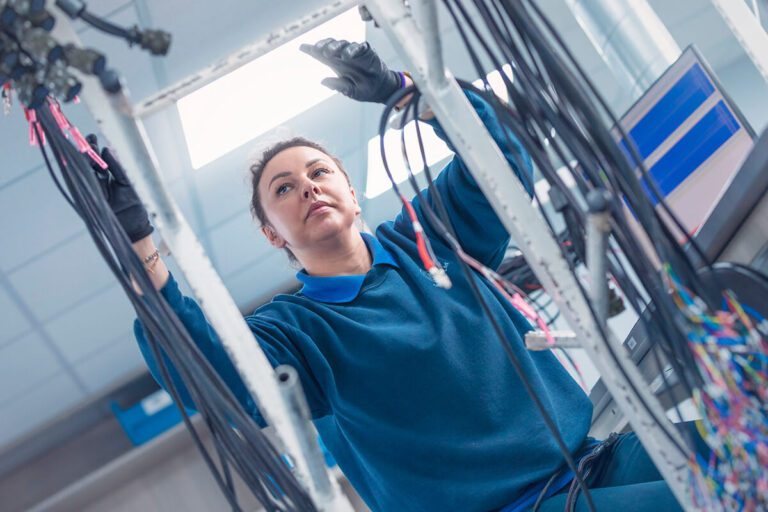Home » Cable Assembly » Cable Assemblies vs Wire Harnesses: What’s the Difference and Which Is Right for Your Project?
Choosing the right cable solution is critical when designing or manufacturing a new product. Whether you’re building industrial machinery, defence technology, or medical equipment, efficient cable management affects not only performance, but also safety, speed of installation, and long-term reliability.
Cablepoint specialises in providing both custom cable assemblies and wire harnesses for a wide range of demanding industries. But which one is right for your application?
This guide breaks down the difference between cable assemblies and wire harnesses, compares their use cases, and explains how to choose the most appropriate option based on your technical and environmental needs.
What is a Cable Assembly?
A cable assembly is a collection of wires or cables bundled together into a single structure and enclosed in an outer jacket. This external sheath offers physical protection, environmental resistance, and a neater, unified installation.
Cable assemblies are typically used when durability, ingress protection, and external exposure are key factors. Cablepoint assemblies can include overmoulded connectors, custom potting, waterproofing, or EMI shielding, depending on your requirements.
Common features of a cable assembly:
- Fully enclosed with a protective outer jacket
- Assembled to exact lengths and pinouts
- Customisable with overmoulding, potting, or grommets
- Suitable for external or rugged environments
- Built for plug-and-play installation
What is a Wire Harness?
A wire harness (also known as a wiring loom) is a structured arrangement of individual cables bundled together – usually without an external jacket. Instead, harnesses are held in place using cable ties, sleeves, or binding straps, allowing individual wires to branch off at defined points.
Wire harnesses are ideal for complex routing in internal applications, such as inside vehicles, control panels, or machinery. They simplify multi-connection systems and speed up final assembly.
Common features of a wire harness:
- No external overjacket
- Multiple breakouts and branch points
- Lower weight and more flexibility
- Ideal for enclosed, internal installations
- Simplified design using a loom board
Cable Assembly vs Wire Harness: Key Differences
Feature | Cable Assembly | Wire Harness |
Protection | Fully enclosed, weather-resistant | Minimal protection, mainly internal |
Flexibility | Moderate | High – cables can branch and split |
Durability | Built for tough or external environments | Best suited to enclosed applications |
Installation | Plug-and-play | Requires planned routing and fixing |
Cost | Slightly higher due to materials | Typically lower due to simplified build |
Use Cases for Cable Assemblies
Cable assemblies are designed for high-performance environments where exposure to dust, water, chemicals, or mechanical stress is expected. They are frequently used in:
- Military and aerospace systems
- Medical diagnostics and surgical equipment
- Industrial automation and control
- Outdoor displays, sensors, or power equipment
- Electric vehicle charging solutions
Cablepoint build every assembly to your exact specification. Our team supports everything from prototyping and small-batch work to volume manufacturing with custom overmoulds, sealing, and crimp validation.
Use Cases for Wire Harnesses
Wire harnesses are ideal for complex routing and internal connectivity. They are commonly used in:
- Automotive engines and dashboards
- Consumer electronics and appliances
- Control cabinets and panel wiring
- Robotics and manufacturing equipment
- Data centres and telecom infrastructure
Because harnesses can contain dozens or even hundreds of cables in a single structure, they are particularly effective when space is tight and efficient routing is essential.
Cablepoint uses loom boards and 3D modelling to visualise and assemble harnesses exactly to client layouts, reducing errors and build time.
How to Choose the Right Option for Your Application
When deciding between a cable assembly and a wire harness, ask the following questions:
- Will the cabling be exposed to moisture, chemicals, or abrasion?
Choose a cable assembly with protection and overmoulding. - Does the system require multiple breakout points or routing paths?
A wire harness offers greater layout flexibility. - Is weight or space a concern?
Wire harnesses tend to be lighter and more space-efficient. - Does the application demand rapid installation or plug-and-play performance?
Cable assemblies are quicker to install and replace. - What’s the expected lifespan and service environment?
Cable assemblies offer superior longevity in harsh conditions.
FAQs: Cable Assemblies vs Wire Harnesses
Can I use both in a single product?
Yes. Many systems use wire harnesses internally and cable assemblies externally. We can help you design a solution that integrates both.
Which is more cost-effective?
Wire harnesses are generally more cost-effective due to simpler materials, but cable assemblies may save money on labour, protection, and replacements over time.
What standards do your products meet?
Cablepoint is ISO 9001 and ISO 14001 certified. Our products comply with IPC620 and relevant mil-spec or medical-grade regulations as needed.
Do you provide prototyping and design support?
Absolutely. We assist with BOM analysis, loom board design, CAD drawings, and small-batch builds to ensure design-for-manufacture readiness.
Why Choose Cablepoint as Your Cable Assembly Supplier?
Cablepoint is a leading UK-based manufacturer specialising in custom cable assemblies and industrial wire harnesses. We serve clients in defence, medical, EV, automation, and more. Here’s why customers choose us:
- 30+ years of industry experience
- ISO-certified UK production facility
- Clean room manufacturing and overmoulding expertise
- End-to-end support: prototyping to delivery
- Reliable stockholding and material sourcing strategies
- Flexible volumes: from one-off builds to global supply
Whether you’re creating a new product or refining an existing one, our team is here to help you select the right cable management solution – designed for performance, value, and speed to market.
Need guidance on your next cable project?
Get in touch with Cablepoint today to discuss your requirements or request a quote. We’ll help you identify the best-fit solution – whether that’s a robust cable assembly or a complex wire harness – and support you from design through to delivery.





